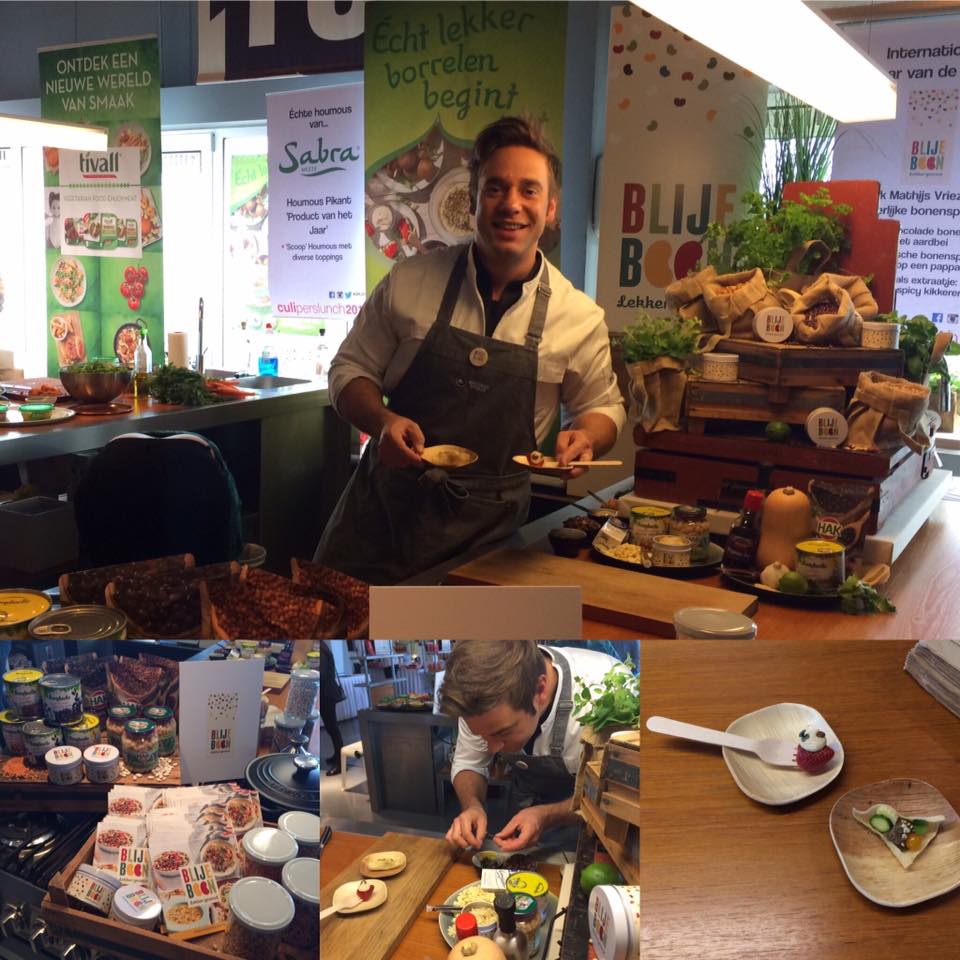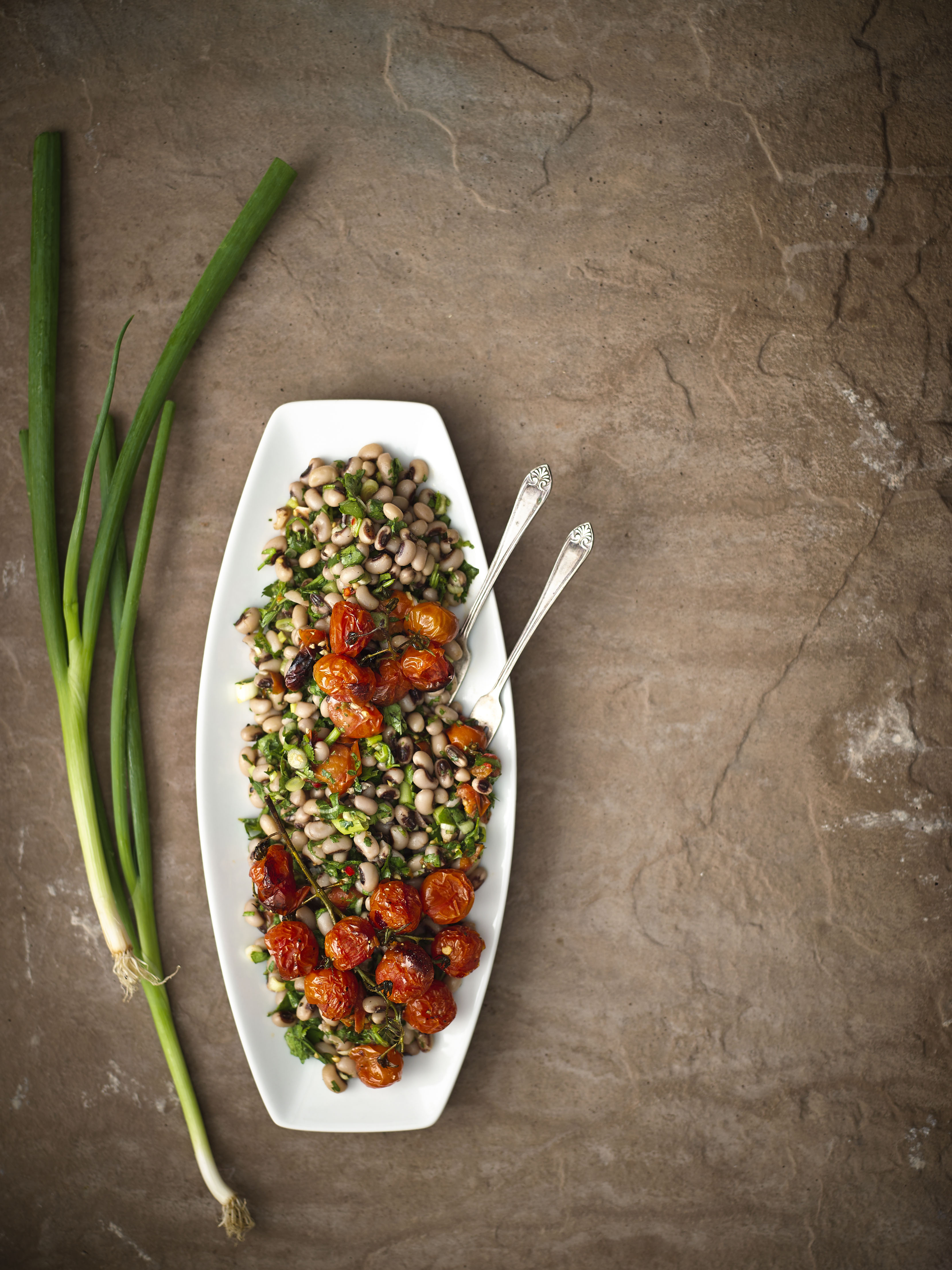- Details
Ward McKenzie has recently released and e-cookbook focusing on pulses to celebrate the International Year of Pulses 2016. Recipes range from soups to salads to hearty meals and even dessert!

- Details
 The great Culiperslunch is an event during lunchtime in the Kookfabriek in Amsterdam with 100 culinary journalists. This took place last Monday for Blije Boon.
The great Culiperslunch is an event during lunchtime in the Kookfabriek in Amsterdam with 100 culinary journalists. This took place last Monday for Blije Boon.
The event contained 15 cooking islands and several stands for all the participants to serve their dishes. The main idea of this event was to bring yourself to the attention of the culinary journalists, inspire them and hopefully have them write about you.
Early in the morning , organisers arrived at the location in Amsterdam to settle for Blije Boon. The Blije Boon team had their own cooking island which they turned in to a spreadbar where tv-cook Mathijs Vrieze presented two bean spreads, an Asian spread with black beans and lentils and a white bean spread with white beans and white chocolate..hmm! The team also had a small snack: roasted chickpeas. They were in a very good mood, because of all the nice flavours and enthusiastic people! Around noon, the event became very crowded and they served their little bites to several journalists. It was nice to talk to them and to hear their enthusiasm for beans.
The Blije Boon team also participated in the goodiebag with their book of inspiration, a little Blije Boon can, a product of Hak and one of Bonduelle.
See the book:
- Details
 The launch of the 2016 International Year of Pulses in South Africa took place in the beautiful city of Cape Town at Greek restaurant Mezepoli. Guests included Nuala Lawlor, the Trade Commissioner of the Canadian High Commission, media, pulse partners and clients.
The launch of the 2016 International Year of Pulses in South Africa took place in the beautiful city of Cape Town at Greek restaurant Mezepoli. Guests included Nuala Lawlor, the Trade Commissioner of the Canadian High Commission, media, pulse partners and clients.
The menu demonstrated the versatility and flavour of many pulse dishes, including falafel, bean salads, hummus, chickpea and pasta rice, as well as a warm lentil salad.
David Lever of AGT Foods Africa presented the benefits of pulses to the global community, which include sustainability, health, water and the environment. “Including pulses in your diet will protect you against a number of illnesses, such as diabetes and cardiovascular disease. It addresses global malnutrition as well as obesity, due to its low cost and nutritional value. The amount of water used to produce pulses is far less than any other crops,” he said.
Maryke Gallagher, president of the Association for Dietetics in South Africa (ADSA), spoke about the many health benefits of pulses. Beans, chickpeas, lentils and peas are nutritional powerhouses that can be enjoyed by people of all ages, from six months to toddlers, teenagers, adults and the elderly. They are a good source of protein, iron and calcium and everyone should incorporate them into their diets.
Guests received a copy of the newly launched pulse recipe book Just so Easy, which features many interesting pulse recipes. People realised just how easy it is to cook with pulses and were inspired to go home and prepare pulse dishes for their families.
The following brands are partners of IYP 2016 in South Africa:
AGT Foods Africa
Dry Bean Producers' Organisation (DPO)
Pioneer Foods – Imbo / Crossbow
Pouyoukas Foods
The Heart and Stroke Foundation SA
The National Science and Technology Forum (NSTF)
Tiger Brands – Lion
Everyone can get involved, visit http://iyp2016.org/ for more information.
ENDS
For further information please contact:
Dean Miller
Group Marketing
Tel: +27 11 762 5261
Or
Kelly Barnett
Caro Communications
Cell: +27 82 776 0231
Notes to editors
- The Global Pulse Confederation (GPC) is the global not for profit trade organisation for the global pulse industry value chain. As the sole international confederation for the industry, it enjoys membership from 18 national associations (federations) and over 600 private sector members in an industry worth over $100 Billion at the retail level and over 60 million tons of pulse production and distribution in over 55 countries. GPC is headquartered in Dubai http://iyp2016.org/about-us/global-pulse-confederation-cicils-iptic
UN Assembly Resolution on the 2016 International Year of the Pulses: http://www.un.org/en/ga/search/view_doc.asp?symbol=A/RES/68/231&Lang=E
Upcoming Activities
For recipes, nutrition and health information please visit: www.pulses.org or follow #LovePulses on Facebook, Twitter, Instagram, Pinterest and YouTube.
For industry news on IYP go to www.iyp2016.org
Promotion on Social Media
Official campaign hashtags: #LovePulses
Dedicated pulse dish hashtag #PulseRecipes
UN International Year of Pulses hashtag: #IYP2016
Handle: @LovePulses
- Details
This post was written by Marie-Benoit Magrini, Economist at INRA.
Grown on less than 2% of arable land in France, pulse crops are not a common sight on French farms. Yet, pulse crops provide important benefits for agriculture and the environment. First, pulse crops can help in the fight against global warming by taking nitrogen from the air rather than from fertilizers, reducing emission of nitrous oxide, a powerful greenhouse gas. Indeed fertilizers, which enable high yields of major cereal crops such as wheat, barley or maize, are responsible for half of all agricultural greenhouse gas emissions. Secondly, by diversifying simplified farming systems (specialized around cereal crops), addition of pulse crops allows producers to use fewer agri-chemicals and reduce environmental impact. Moreover, pulses have many functional and nutritional properties both as feed for animals and food for people.
Despite these significant benefits, pulse production in France continues to fall. So, what is the problem? Of course, there are several problems, but I will address three of major ways that pulse benefits are under-appreciated.
We know from a recent survey that, at farm level, most French farmers do not consider the ‘real’ economic margin that pulse crops provide.* The annual gross margin for pulses is on the order of 2 to 6 times less than that for major crops. But this ‘opportunity cost’ of including pulses in crop rotations is reduced when the inter-annual net margin is factored in, since with pulses in the rotation farmers can save nitrogen fertilizers and see higher yields and higher quality in subsequent crops (e.g. more protein in wheat).
Few farms have access to technical advising that would help them to properly evaluate multi-year net profits that can accrue from adding pulses to cropping systems. As a result, the economic gain associated with pulse crops often goes unseen. Even when residual benefits to subsequent crops are accounted for, it may not appear sufficient to motivate farmers to grow pulse crops. This is particularly true when wheat prices are high and fertilizer prices are low. For organic producers, the difference of yields and prices between cereals and pulses can be less important. Yet, for most farmers, larger value addition is needed before taking on pulse cropping. This may arise from better evaluation of environmental benefits and also from new markets for pulses.
Under-appreciation of pulse crops results, in part, from what economists call “environmental externalities.” That is, the environmental benefits of growing pulse crops (for instance the reduction of GHG emissions) are not transmitted into market prices and this is a major challenge for attributing the correct economic value of these environmental services. Domestic carbon markets could help in assigning values to environmental benefits as the French InVivo cooperatives have done since 2011. Environmental services payments for farmers applying good agricultural practices could also be a useful lever.
The weak appeal of pulse crops for French farmers compared to cereals is also due to a competitiveness differential between cereals and pulses that has its roots in an historical European preference after the Second World War II: pulses were considered almost exclusively as animal feed, placing them in direct competition with soybean meal imported from America, which provides cheap protein in large quantities. This orientation, driven by public institutions, has meant that research and private stakeholders have neglected to promote pulses in higher value markets for human consumption.
So, the challenge is to create new markets for pulse crops and this may be aided by the transition towards a new nutritional equilibrium between vegetable and animal proteins. However, pulses have traditionally been called ‘the poor person’s meat.’ According to a survey of consumption in France, pulses are seen as ‘old-fashioned’ and changing lifestyles that favor fast-cooking foods have made them less attractive. Therefore, consumer demand for pulses may require food innovations that make pulse consumption easier. For instance, INRA (the French national research institute on agriculture and food) has recently obtained a European patent on pasta made with pulse flour .
So, what can we learn from the story of pulses? Pulse crops have been marginalized by the ‘lock-in’ created by two major factors over the last seven decades: the trend in cropping systems toward homogenization and intensive use of agrochemical inputs paired with public policies and market dynamics that heavily promoted cereals. The push to gain the environmental benefits from diversification of crop systems and the agri-food sector faces competition from the higher economic returns farmers perceive for major crops. To bring them back into center stage, renewed appreciation for pulses is needed both at the upstream and the downstream side of food supply chains.
*A survey conducted with the French National Research Program LEGITIMES (LEGume Insertion in Territories to Induce Main Ecosystem Services) ANR-13-AGRO-0004, https://www6.inra.fr/legitimes.
